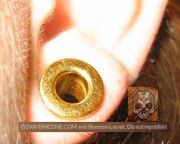|
|
| Line 1: |
Line 1: |
| Some piercers, primarily in Europe (hence the synonym '''European method''') choose to use [[Cannula needle|cannula needles]] rather than hubless hollow [[Piercing needle|piercing needles]]. A '''cannula''' needle is a [[Hypodermic needle|hypodermic needle]] (a standard hubbed hollow needle) but with a plastic sheath on it, also hubbed. If you've ever had surgery, this is the kind of needle medical staff utilize for inserting [[IV]]s.
| | [[File:Bmepb349087.jpg|thumb|right|180px]] |
|
| |
|
| The basic procedure for the piercing (overly simplifying things) is as follows:
| | '''Gold''' is a precious metal often used in body [[Jewelry|jewelry]]. Pure gold is 24 karats, but the gold used in body jewelry is generally an alloy—a combination of gold and another metal, often copper, silver, [[Nickel|nickel]], or zinc. For this reason, people who experience sensitivities to other metal jewelry will likely experience the same [[Allergic Reaction|allergic reactions]] to gold jewelry. Gold jewelry is generally considered too porous for use in fresh piercings. |
| | |
| # The placement is marked with dots at the entrance and exit point of the piercing.
| |
| # In many cases the skin to be pierced is held by [[Clamp|clamps]], but this is definitely not universal (many piercers prefer a "[[Freehand piercing|freehand piercing]]" method). Alternately, for piercings such as a [[Rook|rook]], a pair of [[Mosquito forceps|mosquito forceps]] or similar device may be used to support the tissue, and for piercings such as [[Nostril piercing|nostril piercings]] and [[PA|PAs]], a [[Receiving tube|receiving tube]] may be used to both support the tissue and "catch" the needle.
| |
| # The piercing is done with a [[Catheter|catheter]] (cannula) needle with both the metal needle and the plastic sheath.
| |
| # The metal needle is pulled out of the body of the cannula, leaving just the cannula (a hollow flexible plastic tube) in the piercing.
| |
| # The jewelry is inserted into the cannula, and then the entire thing is pulled back out in the opposite direction it was placed.
| |
| # The needle and cannula are discarded, leaving only the jewelry in place.
| |
| | |
| [[File:Cannula Piercing-1.jpg|500px|thumb|center|]]
| |
| | |
| There may be some additional discomfort, and slightly more bleeding from the cannula, but many piercers believe that the increased ease of follow through more than makes up for it. In addition, the simplicity of this technique can make it ideal for home piercing by inexperienced "piercers".
| |
Latest revision as of 04:28, 17 September 2023
Gold is a precious metal often used in body jewelry. Pure gold is 24 karats, but the gold used in body jewelry is generally an alloy—a combination of gold and another metal, often copper, silver, nickel, or zinc. For this reason, people who experience sensitivities to other metal jewelry will likely experience the same allergic reactions to gold jewelry. Gold jewelry is generally considered too porous for use in fresh piercings.
